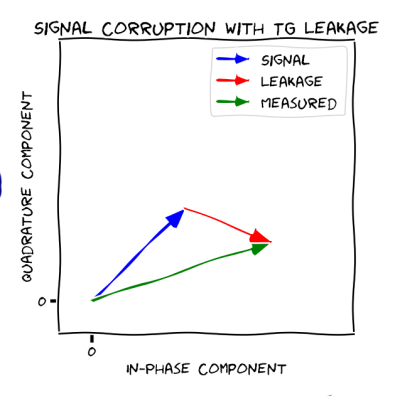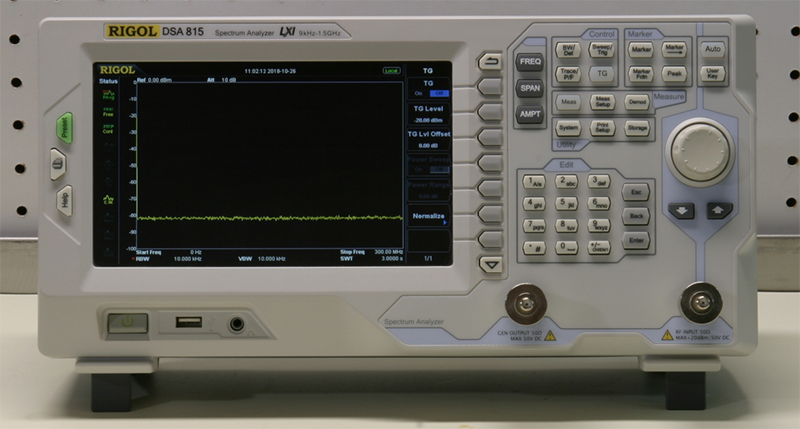The Hackaday Superconference is all about showcasing the hardware heroics of the Hackaday community. We also have a peer-reviewed journal with the same goal, and for the 2018 Hackaday Superconference we got a taste of the first paper to make it into our fully Open Access Journal. It comes from Ted Yapo, it is indeed a tale of hardware heroics: what happens when you don’t want to spend sixty thousand dollars on a vector network analyzer?
Ted’s talk begins with a need for a network analyzer. These allow for RF measurements, but if you ever need one, be prepared: you can spend twenty thousand dollars on a used VNA. Around the time Ted’s project began, Rigol released their cheap spectrum analyzer, the DSA815. This thing only cost a thousand dollars. It was their first revision of the hardware, and it was only a scalar network analyzer. Being the first revision of the hardware, there were a few problems; there was leakage that would affect the measurement. The noise floor was higher than it should have been. These problems can be corrected, though, with a little bit of cunning from Ted:
Ted’s Rigol spectrum analyzer consists of two basic parts. The tracking generator generates a signal, which is fed through the device under test. The spectrum analyzer receives the signal coming from the tracking generator, through the device under test, and puts lines and numbers on the screen. If you’re measuring how well a device performs at 100 kHz or 1 GHz, this is what you need.

The problem comes with the leakage between the tracking generator and the spectrum analyzer. Without anything plugged in, the noise floor of this spectrum analyzer was at -90dB, while the leakage was measured at around -70dB. This was measured through an HP355D variable attenuator, and for measuring signals that low, this cheap spectrum analyzer was basically useless.
This was a scalar network analyzer, though, not a vector analyzer. Ted found the effect of the leakage on measurement results could be manipulated by changing the phase shift of the signal. Simply by using a commercial diode mixer (a few diodes and a few transformers), the phase of the signal from the tracking generator can be inverted 180°. Since the phase is inverted, the measured signal changes with respect to what it should be. A little bit of math, and you can reasonably correct for this leakage in the machine.
The result with this new setup is a scalar network analyzer that’s remarkably better than the stock machine — up to 30dB of dynamic range better. Keep in mind this problem has been corrected in newer revisions of the Rigol spectrum analyzer (Ted says the serial number of his machine is very low, in any event), and this shouldn’t be taken as a review of this particular network analyzer. It is, though, a remarkable tale of hardware heroics and using brainpower when you don’t have the cash to buy the fantastically expensive tools you need.
Ted’s talk is great, and he’s also written a paper on his work, published in the first edition of the Hackaday Journal of What You Don’t Know. We’re always looking for new articles in our Open Access Journal, so if you have a sordid tale of doing something that shouldn’t be possible, think about submitting your own paper to the journal.
















I’m confused,
Network Analyzer…
Spectrum Analyzer…
Network Analizers measure the reflection and transmission coefficients or Scattering Parameters (S-parameters) for a given N-port network.
Whereas a spectrum analyzer can read signals in the frequency domain and show the amplitude of signals at given frequency (Think fourier)
Spectrum analyzer shows the components, in frequency and amplitude, of a signal. Scalar network analyzer shows the response, in frequency and amplitude, of a device or “network”. (It works by injecting a signal into the network and measuring the output.) Vector network analyzer shows response, in frequency, amplitude, and phase, of a device or network. You can make a scalar network analyzer by combining a spectrum analyzer and a tracking generator. A tracking generator is a signal generator whose frequency tracks the frequency of the spectrum analyzer. Many spectrum analyzers include tracking generators.
Can be even more confusing.
Recently though, I was looking at auction ones for sale and came across new variants I’ve never heard of before like ENA, PNA, y-parameters, z-parameters, h-parameters and seems some other parameters that I am not recalling.
Thinking the SDRPlay or LimeSDR performance might be similar for a hacked together spectrum analyzer that might even have wider bandwidth, frequency range and if full duplex… can be made to be a tracking generator also. Not sure what would have to be shielded more on the boards however… machined casing, etc. Might need some improvements to prevent coupling.
I just checked signal hounds site and wow… they’ve updated and upgraded their systems from what I last recall. I was thinking they were cheaper. Same goes for ThinkRF… though I knew that was a used one I’ve eyed on eBay which is still ~$3k.
I’m starting with a simple module based approach with cheap chipset modules. Basically, the latest design by the creator of Tapr-VNA. We’ll see if this gets built in the next few years. :D
So… what can a VNA do that a TX/RX SDR can’t?
Assuming the transmit and receive chains are phase synchronized, a full-duplex software defined transceiver plus a directional coupler or two can, in principle, do the same things as a VNA. The SDR will probably have much less dynamic range, poorer linearity, greater variability over frequency, and generally a much greater tendency to lie to you because of non-ideal behaviors.
The tens of thousands of dollars aren’t spent to make the VNA exist; they’re spent to make the VNA good.
The ‘very’ short answer is ‘software’.
What you really want to ask is ‘has anyone setup a T/Rx SDR to be used as a VNA.
The answer is yes – a guy known a DG8SAQ built one in 2008 (and you can buy the current version).
https://www.sdr-kits.net/introducing-DG8SAQ-VNWA3
And I’m gonna guess that 414 pounds is cheaper than a Rigol, whatever currency you use.
90dB to 500MHz, 50dB out to 1.3GHz? If you don’t need the extra range or gain, this is a valid choice.
Related question – I have one of the other Rigols, with a 50 ohm input. Is there a reasonably-priced probe I can buy so I can safely look at the spectra of voltage signals? I don’t think a regular scope probe would work correctly, or safely?
If your circuit can afford 1k of loading, you can use the dirt-cheap homebrew 21:1 probe described here:
http://jahonen.kapsi.fi/Electronics/DIY%201k%20probe/
It’s usable to 1 GHz without tweaking, higher if you tune it. You may also want to include a fixed attenuator on your SA’s input, depending on exactly what voltage you are probing. I usually over-attenuate at first, rather than risk damaging the analyzer.
Quite interesting! I wish I understood my Rigol DSA815TG better !
For hobbyist needs, miniVNA can be quite affordable.
I would love to have a spectrum analyzer. Not that i need it but it’s cool…
Leakage fro the TG might be fixed by more shielding – which loops back to the recent article on sandwich / oreo / embedded PCB components.